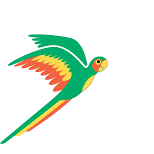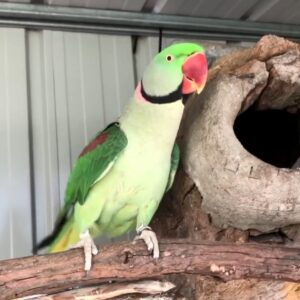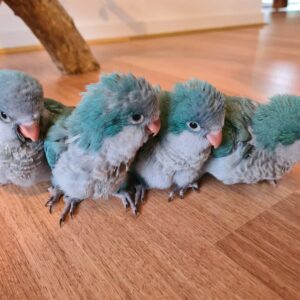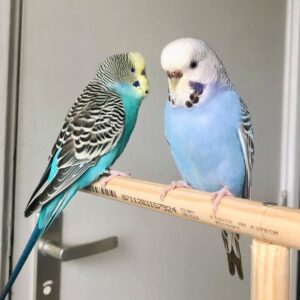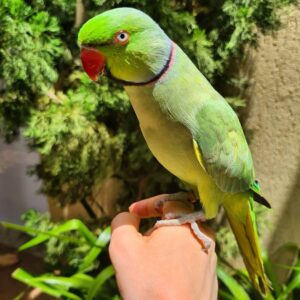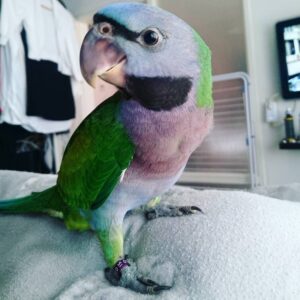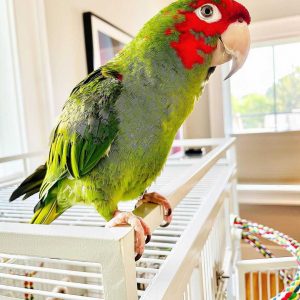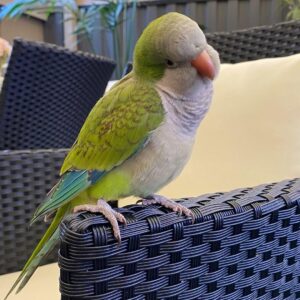Parakeets For Sale
Parakeets For Sale
Parakeets For Sale,these colorful, graceful birds are full of energy. Being flock birds, parakeets are very social with each other and with people. They love attention, make wonderful pets, and are some of the most popular pet birds. There are many different types of parakeets and many are very colorful. The Budgie or Budgerigar, which is called “Parakeet” in the United States, is one of the best-known parakeets. However it is just of more than 120 species and sub-species.
These small parrots are not only intelligent, but they have outgoing personalities and are very social. Parakeets adapt quickly to their cage and can be quite playful. They are very dexterous and are constantly on the go. To keep them happy and healthy they need a stimulating environment with lots of activities, including climbing areas and chewing toys. Because Parakeets are social birds that live in flocks in the wild, keeping more than one is important for their well-being. They will also form a close, loving bond with their human flock, and become a great friend and companion.
Social Behaviors of Parakeets
Parakeets are very social with good personalities. They are friendly to people and like lots of attention and handling. Both males and females make equally good pets.
Parakeets are flock oriented birds, which contributes to their needing a full-time companion. It is best if you can keep them in pairs or in small flocks. Pairs of breeders should be housed separately, however, as many species become aggressive during this time.
Handling/Training of our Parakeets for sale
Taming and training parakeets is pretty easy. Parakeets become accustom to their new environment fairly rapidly. Consequently very little time is required for parakeet training, they can quickly become easy to handle. Repetition, patience and time are the keys to successful parakeet training!
Taming Basics
Even though parakeets quickly adapt to their enviroment, you should give a new arrival a few days to get use to you, your voice and its cage before trying to handle it. A hand fed baby will not need much taming and can often be handled right away, as it is use to human attention. To be able to handle and train your parakeet depends first on trust, so go slowly and be consistent.
Remember that taming and training a bird takes patience, never ‘punish’ your parakeet! This only serves to destroy the trust you’ve spent so much time building.
Initial Training
Speak softly to the bird to calm it and always move slowly. Start from the floor and approach the bird from the side rather than head on. With a treat held between two fingers, coax it onto your hand. It may try to fly and you may have to repeat this several times. Once your parakeet steps on your hand, you then start having it step up from one hand to the other.
If necessary, you can repeat the hand-taming lessons several times a day but for short periods of time, about 20 minutes a session. Depending on the tameness of the bird, these two steps can be instantaneous as in a hand fed baby. Or it can take several weeks or longer for an untamed bird.
Advanced Training
Repetition and frequency are the keys here. Almost every parakeet can learn at least a few words, although they are not generally as vocal as African Greys or the Amazons.
Temperament
Budgies are gentle and docile birds. They are also very easy to tame, especially if acquired at a young age. Pairs of birds make good company for each other, but when in living pairs and entertaining one another, they may not bond as well with their owners or mimic speech as fluently. Budgies are also very playful, active, and quieter than some other types of parrots.
Maintenance:
The basic cage care includes daily cleaning of the water and food dishes. Weekly you should wash all the perches and dirty toys, and the floor should be washed about every other week. A total hosing down and disinfecting of an aviary should be done yearly, replacing anything that needs to be freshened, such as old dishes, toys and perches.
Habitat
Make your parakeet’s habitat as large as possible. The minimum size of habitat for one parakeet is 18″ W x 18″ D x 18″ H, with metal bars spaced no more than 1/2″ apart.
Making your habitat
Parakeets for sale adapt well to average household temperatures, which should not fall below 65°F or exceed 80°F; extreme temperature changes should be avoided. The habitat should be placed off the floor, away from drafts, and out of reach of other pets. Make sure there are no habitat parts or toys that contain lead, zinc, or other potentially toxic heavy metals, as well as lead-based paints or galvanized parts, as these can cause serious medical problems if birds ingest them.
Perches: Perches should be at least 4″ long and 3/8″ in diameter; a variety of perch diameters is required to exercise your bird’s feet and prevent pressure sores on their soles from developing. Sandpaper covers on perches are abrasive to the feet and should be avoided.
Habitat Liner : A metal grate over the habitat bottom keeps droppings fall away from your bird’s feet and keep the habitat cleaner; line the tray in the habitat bottom with habitat paper or other paper-based products to ease cleanup and minimize dust.
Colors and Markings
The normal wild coloration of a budgie is a light green with black bars on its wings, back, and head. Typically mature females have a tan or beige cere (the fleshy part around the nostrils), and the males have a bluish cere. Young budgies also have bar markings on their foreheads that recede with age, and their eyes typically have dark irises that gradually become gray with age. Through selective breeding in the pet trade, a huge variety of colors and patterns are available, including violet, blue, yellow, pied, albino, and the classic neon green.
Showing all 9 results
-
$550.00 – $1,200.00
-
$400.00 – $900.00
-
$0.00 – $400.00
-
$300.00 – $750.00
-
$600.00 – $1,500.00
-
$550.00 – $1,450.00
-
$600.00
-
$400.00 – $1,100.00
-
$350.00 – $800.00
